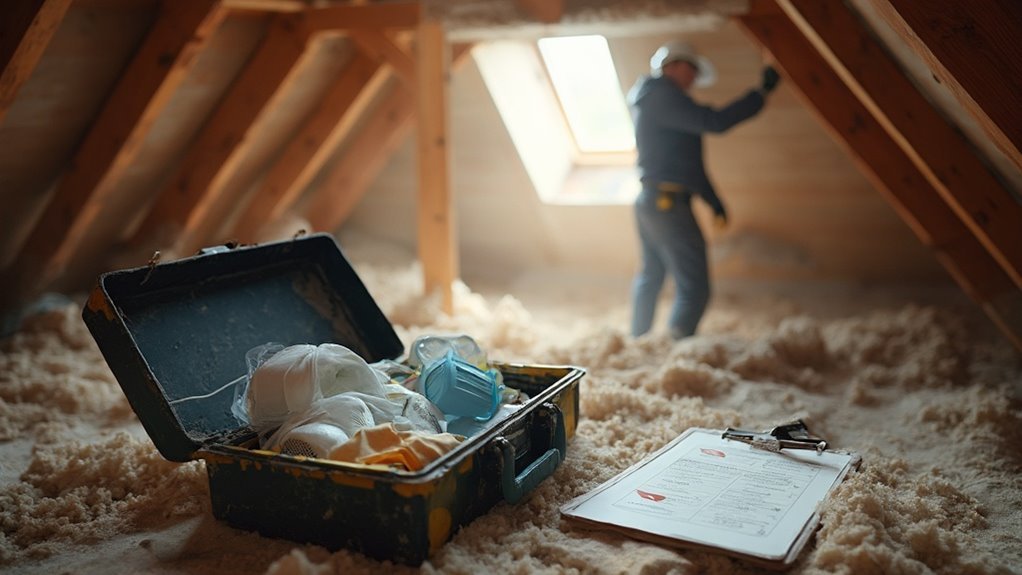To prepare for an asbestos inspection, first confirm the date and scope with your inspection company. Clear areas like attics and basements to provide easy access, and avoid disturbing any suspected asbestos-containing materials. Turn off HVAC systems to prevent fiber spread and keep pets and people away during the inspection. The inspector will perform a visual check, review building records, and possibly sample materials for lab analysis. Understanding these steps helps protect your health and guarantees regulatory compliance. For more details on choosing a qualified inspector and post-inspection actions, further information is available.
Pre-Inspection Preparation Steps

How can you guarantee a smooth asbestos inspection? Start by confirming the inspection date and time with the inspection company. Discuss the inspection's scope to understand which areas of your home will be assessed. It's vital to ask for any specific preparation tips tailored to your property. Review any necessary documents, making certain you provide historical records or any known concerns about asbestos.
Next, clear spaces to aid the inspection. Remove personal items from the rooms, especially those where samples will be collected. Make sure access points to attics, basements, and crawl spaces are unobstructed. This includes clearing access to hatches and minimizing clutter in inspected areas.
Safety gear is vital. Follow containment recommendations from the inspection company and refrain from disturbing any materials that may contain asbestos prior to the inspection. Turn off HVAC systems to prevent airflow that could spread fibers, and keep pets and non-essential individuals away from the inspection area. By taking these steps, you create a safe and efficient environment for the inspection team, making certain a thorough assessment while minimizing risks. Remember, prolonged exposure to asbestos fibers is linked to serious health issues, emphasizing the importance of a proper inspection.
Understanding the Inspection Process
Once you've prepared your space for the inspection, it's time to understand what the process entails. The inspection involves several key steps to guarantee a thorough evaluation of potential asbestos-containing materials (ACMs). Here's what you can expect:
- Visual Inspection: Inspectors will conduct a detailed visual assessment to identify any obvious signs of ACMs.
- Historical Review: They'll review historical records and building plans to pinpoint areas where asbestos may be present.
- Sampling Procedures: If suspect materials are found, samples will be collected and analyzed in a laboratory to confirm the presence of asbestos.
Following this, a risk assessment will evaluate the condition and location of identified ACMs to determine the potential for exposure. Inspectors will adhere to strict documentation requirements, preparing detailed reports outlining their findings, sampling results, and any required follow-up actions. This guarantees you have an extensive understanding of the situation. By grasping the inspection process, you'll be better prepared to address any issues related to asbestos in your home.
Importance of Asbestos Inspections

Understanding the importance of asbestos inspections can markedly impact your health and safety. Exposure to asbestos can lead to severe health risks, including lung cancer, mesothelioma, and asbestosis. Given that many homes contain materials that may release asbestos fibers, an inspection is vital to identifying potential hazards.
| Key Aspect | Health Risks | Regulatory Compliance |
|---|---|---|
| Identifying Hazards | Prevents exposure to harmful asbestos fibers | Required by OSHA, EPA, and local regulations |
| Planning Renovations | Guarantees safety during construction projects | Necessary for obtaining building permits |
| Property Value | Protects your home and health | Increases attractiveness to potential buyers |
Inspections help you comply with regulatory requirements and minimize liability. They allow for early identification of asbestos, enabling you to manage or remove it safely. Moreover, having an asbestos survey conducted before any renovation or demolition project is indispensable for planning and avoiding unexpected costs or delays. By prioritizing an asbestos inspection, you not only safeguard your health but also improve the overall value of your property.
Choosing a Qualified Inspector
Choosing a qualified asbestos inspector is crucial for guaranteeing the safety and compliance of your property. When searching for an inspector, focus on the following key aspects:
- Certification Requirements: Verify that the inspector holds valid certifications from the New York State Department of Labor (NYSDOL) and the New York City Department of Environmental Protection (DEP). These certifications indicate compliance with state-specific standards.
- Training Accreditation: Verify that the inspector has completed accredited training programs, which should cover asbestos characteristics, health effects, and sampling procedures. This guarantees they possess the necessary knowledge to conduct thorough inspections.
- Professional Experience: Look for inspectors with relevant work experience, such as a bachelor's degree or licenses in engineering or architecture, alongside documented experience in building surveys or hazard assessments for asbestos-containing materials (ACM).
Post-Inspection Actions and Follow-Up

After the asbestos inspection, taking prompt and appropriate post-inspection actions is vital for maintaining a safe environment. If asbestos is detected, you must act immediately to protect your family. Depending on the condition and location of the asbestos-containing materials, you may consider asbestos encapsulation, which involves sealing the materials in good condition. Nevertheless, if the materials are severely damaged, removal is necessary, requiring professional involvement.
Always hire licensed and certified asbestos abatement contractors for any remediation or removal. These professionals are trained to handle and dispose of asbestos safely, ensuring compliance with legal responsibilities and OSHA regulations. Attempting to remove asbestos without expertise is dangerous and highly discouraged.
Once the removal is complete, post-removal inspections are critical. These inspections help confirm that all asbestos fibers have been effectively eliminated and that the area is dust-free. Air quality testing may be conducted as well to measure any lingering asbestos fibers. Based on the results, inspectors can advise you on when it's safe to reoccupy your home, ensuring that safety protocols are strictly followed throughout the process.
Frequently Asked Questions
How Long Does an Asbestos Inspection Typically Take?
An asbestos inspection duration typically ranges from a couple of hours to several days, depending on size and complexity. Sample collection timeframe for lab analysis usually takes 3 to 10 days for accurate results.
What Are the Costs Associated With Asbestos Inspections?
Did you know the average cost for an asbestos inspection is around $550? Costs vary substantially because of labor costs, material fees, urban pricing, rural pricing, laboratory fees, and inspector qualifications affecting your final bill.
Can I Stay in My Home During the Inspection?
You can stay during the inspection if you follow safety precautions and containment measures. However, it's essential to minimize disturbance, avoid sampling areas, and adhere to the inspector's guidelines to protect yourself from asbestos exposure.
How Do I Know if My Home Has Asbestos?
About 30% of homes built before 1980 contain asbestos. To identify it, check for visual indicators, like damaged insulation or popcorn ceilings, especially in historical materials. Be cautious of DIY risks when inspecting common asbestos products.
What Happens if Asbestos Is Discovered?
If asbestos is found, you'll need to evaluate asbestos abatement options. Assess health risks, choose removal methods or containment procedures, and address the environmental impact to guarantee safety and compliance during the remediation process.
